Teaching in the Time of COVID-19: What Have We E-Learned?
Life in America, and around the world, has changed dramatically in the face of COVID-19, and nowhere is that change more stark than in our institutions of learning. As communities entered into lockdowns and quarantines, educators were suddenly thrown into the position of adapting classroom plans (many of which had been written months in advance or were equipment-dependent) for an uncertain transition into e-learning. As the school year rolls to an end around the country, we gathered first-hand accounts from teachers on the frontlines, who shared the positives and negatives they’ve experienced. In short, what we have learned about e-learning?
Editor’s note: Some names have been changed to honor requests for anonymity. Those entries will be noted with an asterisk.
Dawn Jukes, Elementary Teacher, Indianapolis
Jukes has been teaching kindergarten and elementary school students from a wide variety of backgrounds for 23 years. She taught for the Indianapolis Public School system for 20 of those years.
Jukes: I teach for inner-city Indianapolis and two of my students don’t have WiFi at home, so they haven’t been able to do online e-learning. Out of 23 students, 10 have computers and the ones who don’t, try to do e-learning on phones and tablets. We have made packets twice as a second option. About 80 percent of our students picked up their packets the second time. I do Zoom two to three times a week and I usually have three to six students (out of 23) on it. I even do one evening, because a lot of my parents are still working. I’ve had parents tell me they work till six and have one tablet for three kids to do their e-learning on once she gets home. I send out weekly texts for free food pick-up options. I’ve had a couple parents express to me they’re very thankful. Phalen Leadership Academies (that I’m a part of) even delivers food on Mondays to our families who are in need.
I think my kids who get on my Zoom love seeing each other and having something different to do (I try to find different activities we can do together, or we learn about cities or countries I’ve visited, and talk about what is going on.) PLA also put together an e-learning website for students to use. It has 30 math and 30 ELA lessons per grade. I know some of my students definitely use it. I just wish all of them could.
Mary Ann Abramson, JAG (Jobs for America’s Graduates) Instructor
JAG is a nationwide high school (and in some cases, middle school) program, available in over 30 states. JAG “consists of a comprehensive set of services designed to keep young people in school through graduation and improves their success rates in education and career.” The program emphasizes project-based learning, collaboration, and internships, all of which were dramatically affected by the nationwide pandemic. Mary Ann Abramson is a JAG instructor at the high school level.
Abramson: This has definitely been a learning experience for me. My class model relies heavily on student interaction and input, so not having that at all felt like I was teaching blind. I couldn’t tell how the assignments were going, how much time it was taking students to complete them, or redirect when my instructions may have been misunderstood.
I think the three things that helped me the most through this e-learning pandemic time period are collaboration, self-care, and grace. This experience of trying to conduct school during a pandemic was new for absolutely everyone. Collaborating to share lesson plans, web sites, and stories of what has worked, and not, was helpful. It was truly humbling to see how teachers from across the nation were finding ways to share information and resources. Including students in the process was helpful as well, allowing me to structure assignments that truly met the needs of the students where they were as far as resources and emotional health.
This transitions nicely into my next piece of advice, the importance of self-care. Self-care is such a buzz word, but I found it to be a real lifeline for me and my family. Experiencing this, I made assignments for my students designed around finding a new activity, or revisiting an old one, that they could implement when they were feeling overwhelmed or increasingly upset about the way their school year ended. The feedback from students was very positive, and allowed for a good discussion at our weekly Zoom meeting.
The last one, grace, is something we all need to extend to one another, and ourselves, throughout this whole ordeal. Like I said before, this is new for all of us. Teachers, students, parents, even administrators… we’re all trying to do our best. We’ll come out of this better by working together, taking care of ourselves and granting one another a measure of grace along the way.
Dr. Lori Henson, Instructor, Indiana State University
Dr. Lori Henson is a seasoned journalist and an Instructor of Communication/Journalism. She’s taught in multiple formats, including online instruction, for three colleges over the past 17 years. She’s been with ISU since 2012.
Henson: 1. You can’t prepare for a moment like this.
I teach journalism at Indiana State University. I’m pretty comfortable with online education. My materials are online in a typical semester, and at Indiana State University, we use a course management system that students use to access materials and communicate about course assignments. All this familiarity made me think the transition to online teaching would be relatively seamless, even under the difficult circumstances. What I didn’t expect was how difficult it would be to reimagine how to teach journalism when the central idea of going places and talking to people isn’t possible. I had to work around those limitations by finding online and media content that would be useful and accessible for students and meet the course objectives. All of this done on a tight timeline.
2. Students are not alright.
One of my students is now the primary caregiver for her grandmother who was moved out of her nursing home as a precaution. Another student lost both her grandparents to COVID-19. An untold number of my students are paying their way through college as essential workers at grocery stores, factories, restaurants, warehouses, as delivery drivers, and even healthcare and childcare workers. Many have to fight for time using WiFi at public locations. Adjusting to online course work adds to their stress. When I realized what they would be facing, I determined it was not time to ask them to adapt to new apps, software, or even scheduled streaming meetings. It was not time to add to their workload, or even to their total news consumption about the pandemic. It’s simply not practical or kind.
3. The pandemic is offering an education of its own.
I cannot count the number of heroic acts of kindness, generosity, and public service our students and faculty and staff have initiated in this terrible time. Some of our university’s social work students and faculty are leading a mutual aid group in our community, to get resources to those at risk. Our students and faculty are marshaling their talents and labor toward serving others, researching solutions to all kinds of problems the pandemic presents, and keeping our world moving. Students and educators — in various ways, and with mixed results — are learning to cope, to build community, and to care for their mental and physical health in new ways.
4. We are resilient.
As an academic advisor, I have talked to dozens of students about plans for the months ahead. Almost without exception, students tell me they are bored, getting by, and looking forward to getting back to their classes and social lives. Faculty, thrown by the quick transition to online teaching, are looking forward to time to prepare for fall classes, whatever form they take. We are adapting. We are moving forward. And I believe we all have a new and grateful attitude about how much we mean to each other. We won’t take any of it for granted.
Wayne Stantz*, Community College Instructor
Wayne Stantz* and his wife Anne* both teach for a large community college system in the U.S. They have several decades of combined experience teaching both in the classroom and in several distance formats.
Stantz*: Whether it is college or K-12, class time still needs to be class time — plan your time accordingly and stick to it. It’s very common sense to say we need to follow time management, but in practice, we tend to let it go. Students (and people working) need to schedule time for study and keep that schedule. Our classes moved to a “virtual” environment, where we refer to online as the online distance model, and the virtual model is simulated classes taught through Zoom. Class sessions are held at the originally scheduled times, and these sessions simulate interaction for students with their peers and teachers. It’s important for students to keep to the originally scheduled class sessions, as even though they may not have a face-to-face class, they do have a schedule with time set aside for study and interaction with faculty.
This goes along with the idea that if a student is going to maintain that schedule and come to the virtual class, then engagement is also important. It is great to show up and sit in a Zoom meeting and watch, but if the camera and microphone are never turned on, as far as the teacher is concerned, the student might as well not be there. Teachers also need the student response to what they are saying and showing to guide the lesson. We respond to physical and verbal cues from our students to understand areas of inquiry or misinformation- if we don’t get those cues, we will assume everything we are discussing makes sense and move on to the next element. We may miss important learning moments because we don’t “see” the potential need for more clarity.
What I am saying is it is very easy for students to “ghost” — log into a class, keep the mic/video off, and then go do other things. I compare this to the student who comes to class but doesn’t engage, just sits in the room and looks at their phone/computer/sleeps. I laugh to myself when I hear teachers say, “Well, I never have that happen — I engage all my students.” No, you either bully your students to engage, or you don’t look around your room too often. In every room, there is the potential for students to fall through cracks. I’m not saying it always happens, but the potential is always there. Teachers wonder how do we engage all our students all the time, and now that technology makes it easy to “ghost,” that question is doubly hard.
Since the virtual meeting software records sessions, re-watching recordings of missed sessions has been a boon to students, and as a teacher, I look forward to shifts in teaching models when we return to the classroom. I would love for my “normal” classes to be recorded and be available to students who weren’t in class. The potentials for technology usage and different learning environments to co-exist are being proven in real time, instead of being argued about in curriculum and budget meetings, but I fear we will try to return to the old ways without consideration for the methods we are developing.
I’ve learned to be more flexible with deadlines, and that is saying a lot because I was already flexible with deadlines. Already I took the position of “I don’t know the outside life and issues of my students,” so I while holding them to a standard of expectation, I still gave them some ability to work around that. Now, with some of them being in the health or service industry, not only have their schedules gone out the window, when and how they engage with learning has, too. Numbers and attendance follows the online model more than the F2F (face-to-face) idea. Yet, even that has to be flexible — my F2F students weren’t expecting to take an online course — so the blended version of one (part online, part virtual F2F) is attempting to meet them and the situation head on.
In class, I have extroverts and introverts. The extroverts have to learn a bit of control because they can actually overwhelm the technology (the pacing of “phone” conversation is different than F2F). The introverts actually do well in the course — less direct peer intimidation. This doesn’t mean levels of fear of public speaking or engagement are gone, but the structure is different — there is a removal of the physical space and trappings. This allows them to have control of the environment they are in, to have control of their safety zones. And in that they might draw more comfort and not be overwhelmed by some of the environmental issues of a classroom full of people.
Assignments have to be different — online structured instead of classroom structured. I’m not saying that class activities can’t occur, but when half of your class may be unable to attend because of work, of family sickness, of technology issues, then the idea of having a 20-minute class activity that all participate in goes out the window — student led learning is now the model.
Giant packets of copied materials don’t work — they overwhelm and ultimately the teacher has to ask what did the student learn, and on a practical level, how am I going to get all that work back. I feel bad for my child going through this fake level of learning. He isn’t. He is doing his best to finish each generic assignment. The educational year is lost. I feel bad for the lost potential and wasted time. I suppose there were good intentions in the learning packets, but I’m not sure I see them as much as I see a rushed response to meet expectations.
The lesson I think I’ve learned is that we (America) could have done better. We squandered time and resources, hoarded money and floated false notions of liberty and freedom out of fear of change and selfishness. Teachers and students can’t do our best because there is such broad economic disparity between who has access to support and technology. This limits the ability to take advantage of what can be done. There is obviously poor leadership on all levels — not out of good intentions — I would never mind mistakes out of good intentions.
Helpful strategies for students?
Treat class time (virtual or otherwise) as a scheduled event. Time management is important, and so is learning. Be in your “class” when you signed up for it and treat it as if it is still going on.
Your teacher should still be there to lend support and explain the lesson — just because they sent home a packet, doesn’t mean they are off the hook. Send an email, talk online, but let them know that your learning is important to you and you need help
The hardest lesson for me was that not every assignment is worth breaking yourself for. Some things just don’t need that much stress over. Weigh the expectation and the goal — in the face of 40 equally poorly written assignments, letting go of depth isn’t letting go of learning. (That’s aimed at my child’s current school experience.)
Communication is important- outside of class, your teachers want to know what is going on so they can help you. Keep them up to date. Let them know where you have questions. There aren’t dumb questions.
READ EVERYTHING. Explore the world. Read the news (not just your favorite sources). Know what is going on and why. Ask questions.
Matt Brady, High School Science Teacher and founder of TheScienceOf.org, North Carolina
Matt Brady is a high school science teacher in North Carolina. He’s also the founder of the popular website www.thescienceof.org, which uses pop culture to teach larger scientific principles, and a co-founder of pop culture news site www.newsarama.com. Brady wrote The Science of Rick and Morty: The Unofficial Guide to Earth’s Stupidest Show in 2019.
Brady: I’ve learned again how deep inequality runs. I’ve “lost” students to work as their only, or both parents, have been laid off or live in fear of being laid off, and press their teenager to get a job because “we just don’t know.” And when in the days before we stopped physical school, asking students to participate in a survey about who had a device and WiFi at home wasn’t as thorough as it could have been, and students didn’t understand what it meant. A phone is not a device on which you can do schoolwork. A laptop is. But kids don’t want other kids necessarily to know that they don’t have one. Same with WiFi. You can’t watch hour-long videos for each of your classes on Cricket minutes, or pay-as-you-go plans. And that’s just technology and doesn’t touch food. Or shelter, or a place to go where you won’t get hit whenever someone drinks. As far as inequality goes, we’ve been yelling this for years and years, and this shined a white-hot light on it. Whether we do anything about it is always the question, but having worked in public education for a decade-plus, I fear I already know the answer. Probably just lots of words that make the people saying them feel better about themselves, but very little or no action.
There were, at least for my district, no plans ready for this, and I figure that was the same for many others. That’s…understandable given the tightness of budgets and how “war-rooming” would be a luxury, spending money to talk to consultants and pay staff to speculate about scenarios and how to respond. But if we can level this criticism at the administration, we can level it at every smaller organization that is an essential need: we knew this was coming. There was no plan. There was deferring to authorities, either local or state, who also had no plan. We were all Indiana Jones going after that truck in Raiders of the Lost Ark — we were all just making it up as we went along, and like Indy, we did okay. But…this is going to happen again. We’ll be remembered by history for how we made do on this one. We’ll be judged by history on how well we’ve prepared for the next wave of COVID, the next pandemic, or whatever emergency situation arises that requires long-term off-site learning.
This has reaffirmed that a lot of kids — despite the manic-ness of teenagers on TikTok and others — are not okay with this. Those of us who’ve chosen to stay in daily contact with our students are putting our training in “cries for help” to use and have quickly become experts at the “language” someone uses when they’re in trouble. The words not being said as well as the words being said. The order of the words. A shy student who’s desperately chatty. An e-mail from a student saying, “I quit.” Schools have amazing supports built-in for students, and it guts me that we’ve had to use them pretty much non-stop through all of this.
Related to this, I do have a lot of kids who are putting in the work who will probably admit that the work — the regular expectations of my class, of their math class, and others — have been their lifeline, their crutch to keeping something of a “normal” feel to their days and weeks. Some had issues, some had to bow out to work, and yes, some did ghost us, but overall, they kept at it. They kept learning. The future will be okay, ultimately.
Some kids like this, and respond better to online, at-home learning than in-room, in-school learning. I’ve seen some of my quieter kids, and some with challenging situations, utterly blossom and do some of the best work of their time in my class. For some, the distractions and social pressures of being in school were the issues. I’ve been humbled by how well some of my kids are doing.
Kids need to see that their teachers are vulnerable and that we’re in this together. This was not the time for teachers who get off on being dicks to their students to continue that, just online. I made a point to pull my class together as a community. I wrote a Corona Diary entry every day which was half stuff they needed to do, and have me journaling about the time, how I’m doing, and how I hoped they were doing. We had a class playlist so we can remember this time. I told them about how much Mother’s Day sucked for me since my Mom had passed away in December. I told them that I had up days and down days, and sometimes, all I wanted to do was just lie on my couch with the TV on, not paying attention to it. I held my due dates as flexible and offered them do-overs if their heads weren’t in the game when they had to do the assignment. I told them we’d all see each other again someday soon and laugh and remember this, and tell our stories to each other. And I was looking forward to it.
I learned that the public needed stability in all of this, and early on, some of that stability was provided by stories of “hero teachers” going above and beyond…the three percent or so of teachers who’d been pushed online. Those made people feel good for a while and we all laughed and smiled at teachers visiting students and writing on storm doors, and making cute videos and puppet shows, but then the public got tired of those stories and moved on, which was fine, because more and more of us were seeing those stories and feeling like we sucked if we weren’t doing those things if we didn’t have Pinterest-ready backdrops, lessons, and boards good to go. If our whole class wasn’t on Zoom at the same time or however the super-teachers were being shown to be super-teachers. A lot of us were doing the best we could, and it was nowhere near the story we were being told about “all the teachers.” As teachers, often portrayed as the bad guys and the problem, unless we’re taking a bullet for a student, this moment in the sun was…discomforting. And by the way, there have been some “struggling teacher” stories, but those aren’t as feel-good and don’t make people happy, so they’re kind of buried.
A lot of my kids thanked me for that. For being human with them and to them.
I learned that this was not online teaching. These were not online courses. This was disaster response.
Featured image: Shutterstock
Cartoons: Back to School
Want even more laughs? Subscribe to the magazine for cartoons, art, inspiring stories, fiction, humor, and features from our archives.
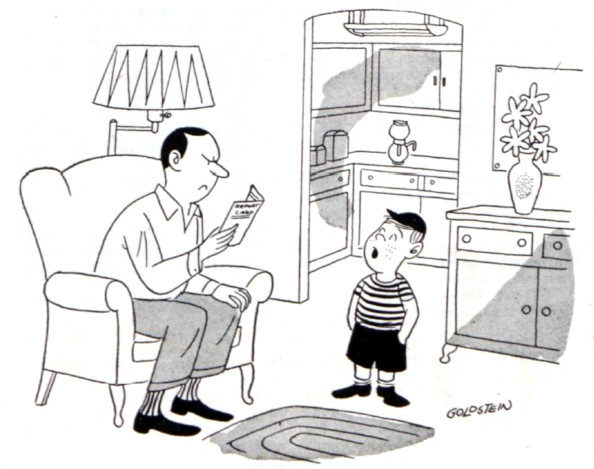
Goldstein
November 17, 1951
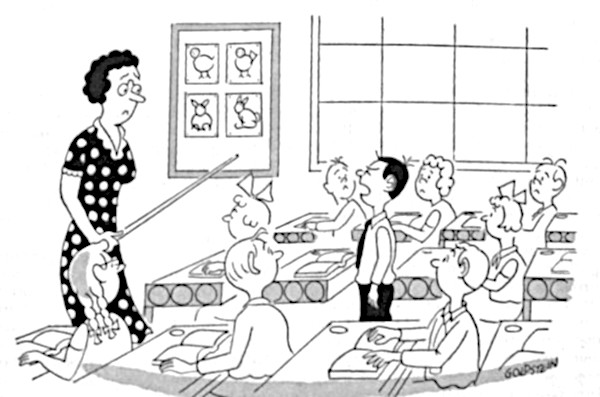
Goldstein
November 4, 1950
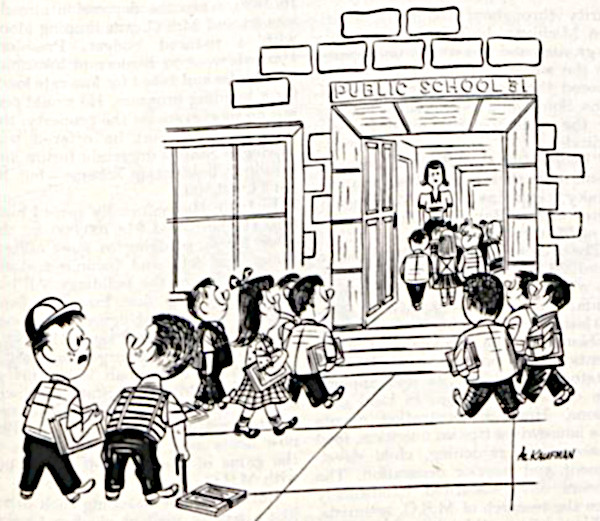
Al Kaufman
October 14, 1950
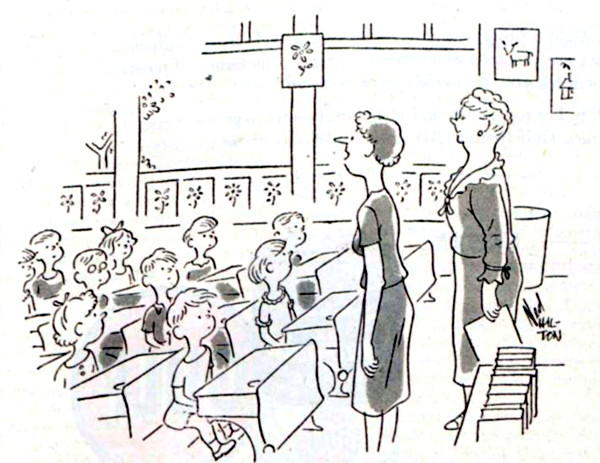
Ned Hilton
September 30, 1950
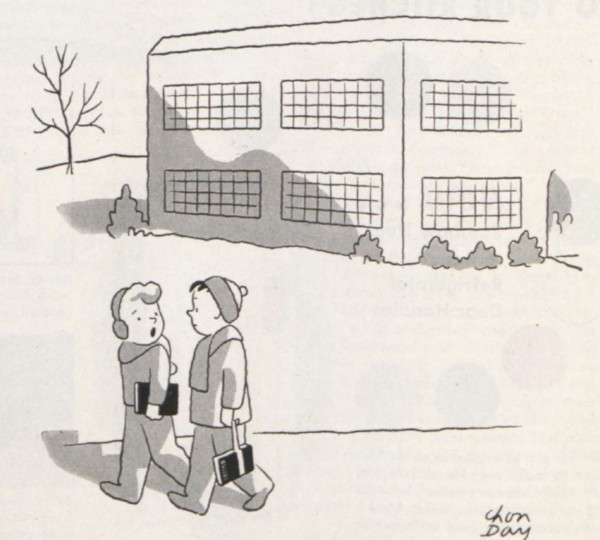
Chon Day
March 17, 1951
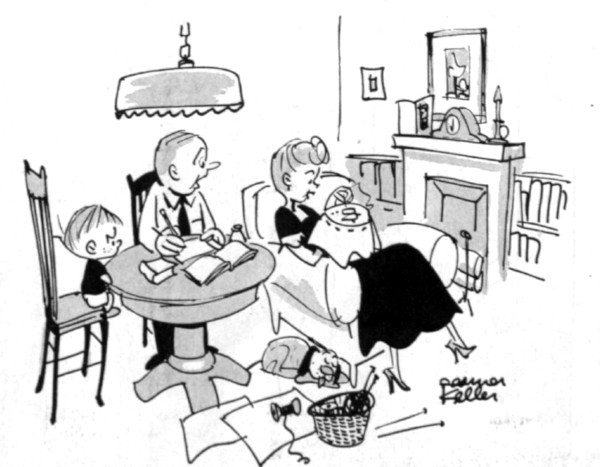
Reamer Keller
February 24, 1951
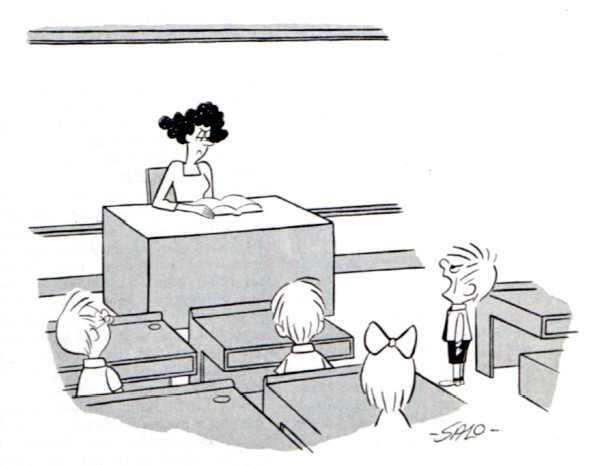
Salo
February 17, 1951
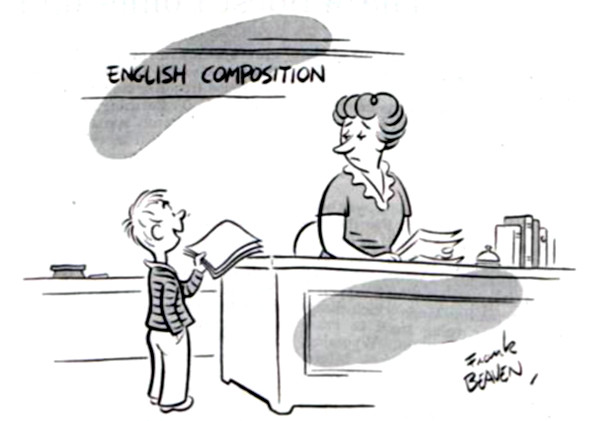
Frank Beaven
December 9, 1950
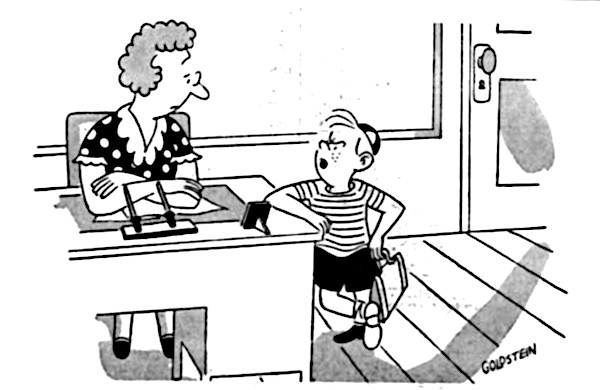
Goldstein
November 18, 1950
Want even more laughs? Subscribe to the magazine for cartoons, art, inspiring stories, fiction, humor, and features from our archives.
North Country Girl: Chapter 8 — Teacher’s Pet
For more about Gay Haubner’s life in the North Country, read the other chapters in her serialized memoir. The Post will publish a new segment each week.
My bookworm tendencies paid off at school, where I was the smallest and the youngest, but definitely the smartest, doted on by all my teachers at Congdon and especially by Miss Ritchie.
On the first day of third grade, I walked into the classroom wearing a new red and black plaid dress with puff sleeves and a dainty smocked top. These Polly Flinders dresses were the height of girlhood fashion; my mother hoped that since I couldn’t make friends, maybe my dress could. The old wood and cast iron desks, with their ancient carvings, slamming seats, and finger-pitching tops, desks that had been welded to the floor since the beginning of time, were gone. In their place were rows of modernish, moveable laminate and metal desks and chairs. The new desks were basically lidded drawers; mine quickly became a rat’s nest of crumpled papers, broken pencils, bits of eraser, and somewhere, the pair of safety scissors I had been issued but lost immediately.
The state of my desk and my awful handwriting were the only things about me that disturbed the adoration of my third grade teacher. Miss Ritchie was white-haired and pink-skinned, with the chest of a pouter pigeon. She wore old-fashioned floral dresses, belted where her waist might have been, thick white stockings and sensible shoes, and smelled of lily-of-the valley toilet water.
I was the undisputed teacher’s pet, Miss Richie’s imaginary daughter or dream pupil or maybe both, and I gloried in it. I was at the top of the class in every aspect of our admittedly unchallenging curriculum: no science to speak of; a smattering of math, mostly multiplication and fractions; something called “Social Studies”, and lots of English, where I shone. Most of our school day was spent on grammar, spelling, vocabulary, reading in our English textbook, and writing. Congdon’s old maid teachers believed the ideal classroom was one where thirty small heads were bent over workbooks, the only sound the scratching of No. 2 pencils or the soft rubbing of pink trapezoid erasers. Since I was happiest with my nose in a book or writing my own stories, this was my ideal too. I was always the first one chosen to read my writing, and the most lavishly praised. No one else in the class had a chance of taking messages to the principal’s office; the other students were relegated to the lowly tasks of erasing the blackboard and emptying the pencil sharpener. I was especially glad to be relieved of that job, as I always ended up dumping about a pound of shavings on the floor trying to wrestle the sharpener off the wall.
Miss Ritchie chose me as one of five students from her class to audition for the school choir; upon hearing me sing, the choir leader’s eyebrows shot upward, and she ordered me back to the classroom. I hate to suspect that it may also have been Miss Richie who condemned me to Remedial Speech. My r’s were certainly not robust and rolling, but they were definitely not w’s. Yet once a week I was pulled away from the glories of books and fractions and sent off with the three stupidest boys in the class, all of whom had terrible lisps. We sat miserably around a table in the school library, while the perky speech therapist played card games with us, making sure that my cards always included the red, red robin and the three dumbos got dealt pictures of slides, snakes, and snow. I don’t know if I was cured, or the speech therapist moved away, or if someone took pity on how unhappy that hour made me, but I only had to endure one year of moronic games featuring words starting with R.
Other then the new desks, Miss Ritchie stuck to the classics. We started every day with the Pledge of Allegiance, followed by “My Country Tis of Thee,” “God Bless America,” “America the Beautiful,” or on dreadful days, the unsingable national anthem. Once or twice a week, Miss Ritchie would pass out songbooks and take us through “Shenendoah” or “Alouette” or “My Old Kentucky Home.” There were no objections to the line “Twas summer, the darkies were gay” as few of us Duluth children had even laid eyes on a real black person. That was the music curriculum. For art we made seasonal classroom decorations, drew illustrations for our weekly book reports, and occasionally and wonderfully, instead of a crayon drawing, brought shoeboxes from home to create dioramas depicting a scene from our book.
Once a year, all classroom work was suspended for the Iowa Tests of Basic Skills; I went into a zen state, a blissful inner peace penciling in those tiny ovals, knowing I’d score in the high 90s on every subject. There was no test prep; we were told what day the tests would be and mildly threatened not to be absent that day and so inconvenience the entire school by having to take a make-up test.
We began the school year decorating the room with leaves cut out of orange, yellow, and red construction paper. When the leaves were replaced with thirty practically identical jack o’lanterns, it was time to pick out a Halloween costume.
The traditional Congdon Halloween school parade was the only time anyone could actually admire your costume; trick-or-treating at night in Duluth required at least a coat, and more likely hat, scarf, and mittens as well. Wearing a costume to school felt like the height of transgression. And how to choose? Sleeping Beauty? Cinderella? Alice? Which plastic mask you could barely see out of, with elastic that snapped off of the staples almost immediately, which scratchy, glittery dress?
Each class in turn paraded through the school, showing off their costumes to the twelve other rooms: two classes in grades 1 to 6, and one kindergarten class split between morning and afternoon sessions. When we returned to their own classroom there was an orgy of cupcakes, frosted cookies, and bowls of sickening candy corn to gorge on, courtesy of the class mothers.
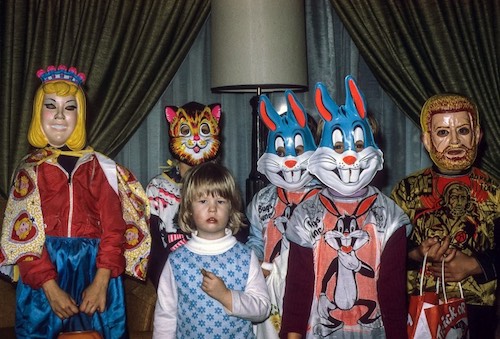
For the most part, homemade Halloween costumes were looked down upon, but one year my sister, probably tired of having to always wear my hand-me-down store-bought costume (complete with busted elastic), insisted on going as a ghost. After finally locating a white sheet, my mother draped it over Lani, cut enough off the bottom so she wouldn’t trip, and then carefully scissored out holes for Lani’s eyes and mouth. Lani toted the brown paper grocery bag she thought contained her ghost costume to school, only to discover that what she had was a white sheet with a girl-sized hole in the middle. When Lani’s class paraded into our room, I tried to shrink under my desk at the sight of her bravely wearing her teacher’s eyeglasses, necklace, and cardigan, dressed up as the child whose mother couldn’t be bothered.
The orange construction paper jack o´lanterns came down, and up went the multi-colored turkeys, looking more like the NBC peacock than barnyard fowl. Immediately after Thanksgiving, turkeys were replaced with paper Christmas trees decorated with a mixture of Elmer’s glue and shake-on glitter; glitter ended up embedded on our new desks, and I would find sparkles of gold and red in my dress pockets for weeks after.
The time between Thanksgiving and Christmas were devoted to that juggernaut, the Congdon Christmas concert, then we were sprung for two glorious weeks of vacation, which meant unlimited if boring daytime TV watching, hours spent reading anything I could get my hands on, and punching my sister until my mother lost it, bundled us both up to the gills, and kicked us outside.
When we trudged back to school in January, the classroom walls were unadorned, and remained so until February, when it was time to break out the red and pink construction paper and add bits of cut up white paper doilies to the palimpsest glued to our desks. Valentine’s Day, like Halloween, was a time of heightened excitement at Congdon. Miss Ritchie assigned a team of girls (led by me, of course) to decorate a large cardboard box, which would hold the class’s Valentines. We devoted hours of classroom time to this pleasant activity. Even more fun was selecting which Valentines to give out. This was done in two stages. First there was the trip to Woolworth’s, that fascinating emporium, permeated with the smell of roasting nuts. There were endless racks of greeting cards to be perused, a rotating display of fascinating gags (Fake vomit! A fly in a plastic ice cube! Sneezing powder!), a pet section in the back, offering rodents, birds, fish, and turtles (plus pink and blue dyed chicks for Easter, two of which showed up in my sister’s and my baskets one year), and an alluring silver lunch counter along the side, which my mother was convinced was filthy and dangerous to eat at. Starting February 1, there would be a special section for Valentine Day Cards. The cards were garish illustrations with punning captions (“I can’t ‘bear’ to be without you” “You’re ‘egg-sactly’ what I like”) to be punched out of thin cardboard sheets, four or five cards per sheet. They came in a box wrapped in clear acetate, so you had to make your decision based on the cards on the top sheet. Some years there would be Hanna-Barbera themed cards, some year Disney. The height of the craft was the card with a candy heart already glued on, a tiny pastel “Be Mine” attached to a smiling bee.

Part two was the selection of a card for each classmate. It was an unspoken rule, completely taken for granted, and never to my knowledge broken: every kid gave a Valentine’s Day card to every other kid. I carefully punched out each card (the ones that ended up ripped got mended with scotch tape and addressed to my least favorite classmates), spread them out on the floor, and started the selection process: who got what card?
I had to determine the best one, to be addressed to my beau ideal, Jim Deere, who was blond, white-toothed, good at sports, and almost as smart as I was. I needed him to read “Let’s be sweethearts” and be struck with the inevitable: we were meant for each other. Then came my favorite girls, the other goodie-goodies: Nancy Erman (my closest academic rival; I had to admit she was better at math than I was), Betsy Strauss, and Debbie Sawyer. After them, came almost albino pale John Bergman, potential boyfriend runner-up (I tried to put out of my mind the fact that his father, my pediatrician, had seen me in my underwear), and the rest of the girls in the class.
My least favorite classmates, Tom Madson, who wore always smeared glasses and was freckled and sweaty, and Billy Shaw, troublemaker nonpareil, got the slightly ripped ones or the small hearts stating simply “Happy Valentine’s Day” that filled out every card collection. The selection process complete, I signed my name on the back of the card, addressed the small white envelope, and licked it shut.
On Valentine’s Day, all the girls dressed in red and pink and all the boys acted as if it were the worst day of their lives, rolling their eyes and barely tolerating the Valentine card ceremony. Having deposited our cards there only a few hours earlier, the Valentine box was torn open, and the cards distributed. Now it was my turn to examine each card as if it were the Rosetta Stone, trying to decipher a secret message of love from the one signed “Jim Deere.” Finally came the feast of pink iced cupcakes and cookies, thanks again class mothers.
Halloween and Valentine’s Day were the Carnivals of the school year, the riotous occasions where all the usual rules were suspended. The other disrupter was the rare and precious snow day. In the face of Duluth winters, school rarely closed, never because of freezing temperatures (just put on another layer!); a full white-out blizzard would be required before the school board would give in to human weakness in the face of the elements. What bliss to be sitting at the kitchen table, eating cornflakes and dressed for school, to hear the radio announce that schools were closed. During one blizzard, the Duluth newspaper ran a photo of my dad heading to his office on our snowmobile, determined to pull teeth no matter what the weather.
Spring brought us third graders a soon-to-graduate-from-college student teacher, who came bearing a stack of slide carousels. This girlish 21-year-old was like an exotic creature who had wandered into our classroom. We had never before seen an elementary school teacher under the age of fifty; we wouldn’t have been surprised if she had to go into deep freeze for the next thirty years before being allowed back into a classroom. Despite her four years of teachers college, she aimed to instruct eight and nine-year-olds in art history. In our darkened classroom, while the boys napped or threw spitballs or snapped rubber bands at each other, the student teacher clicked through hundreds of years of Western Civ, from Rembrandt to Picasso. We were regularly quizzed on identifying artists from their paintings. I had my hand raised and flailing for every slide and got them all right, except for Manet and Monet, who I still get mixed up.
By April, it stopped snowing and the sun struggled to appear a few minutes at noon. The piles of snow left by the plows on the sides of the street shrank day by day, until eventually I could see over the top on my way to and from school. Soon nothing would be left but small humps of sludgy ice along the street gutters. The class cloakroom stopped smelling like wet wool. The beginning of the end of the school year was the first time we were sent outside for gym. Miss Ritchie, who always led gym reluctantly, began by organizing baseball or kickball games, but soon sat back and let us run wild, interfering only when someone (usually me) got decked by a dodgeball to the head.
Back to School
The neighborhood kids are back in school, and productivity is in the air. The little boy next door, Charlie, who knocks on our door and asks for a popsicle, has been red-shirted. He was due to start kindergarten this fall, but his parents held him back, which pleases me. He’s good company for one so young, conversant on a variety of topics, plus has the good sense to know when it’s time to go home, a quality lacking in some adults I know. Like most blessings, Charlie was a surprise. His parents believed their child-bearing years were past; then along came Charlie, to their amazement and our delight. We wanted another child in our lives, and there’s no kid more enjoyable than one you can send home at suppertime.
It’s quiet with the neighborhood children back in school. My wife is with them, manning the library, toting the barge of literacy and healing the twin diseases of sloth and ignorance. My dalliance with formal education ended 24 years ago, but I still feel a delicious rush of freedom each September, the way a convict must feel the day he is escorted to the prison gate and released. I am a fan of knowledge, but have always pulled against the traces of mandatory learning, preferring the self-directed variety.
There is a grimness to education these days, with legislators daily checking its pulse, scanning for tumors, and examining its entrails. I could not bear to be a teacher, having to earn the approval of our nation’s dimmest species — the common politician. Mrs. Conley, my fourth-grade teacher, would not have tolerated this vulgar intrusion into the sacred chapel of her classroom, and I look for our educators to organize any day now, throw off their shackles, and send the politicians packing.
I watch the children stand at the bus stop up the hill from our home. I hear the bus before I see it, slowing to make the corner at our house, its tires humping over the curb, into our yard, then back over the hump and into the street, up the hill past three houses before stopping at the curb. The children step onto the bus with a lightness I never felt as a child on my way to school. I saw a documentary once of coal miners entering a black and joyless hole to begin their day’s labor, and it reminded me of every day I spent at school.
Charlie’s mother works as a nurse twice a week, and Charlie spends those days with his 87-year-old great-grandmother, who sets aside time each day for “school.” She teaches him the alphabet and a dab of math and then sits him on her lap and reads a story. I don’t know what he does after that. He might rot his mind on television for all I know, but I do know the word school has a pleasant association for him, and he can’t wait to go.
My granddaughter is not yet two, but I’ve already told my son and daughter-in-law, both of whom work, that she can ride the bus to our house after school. She will have just been with my wife in the library, and then the baton will be passed to me.
We’ll start with milk and cookies and then chew on her day, her reporting the triumphs and tragedies, me listening¸ giving grandfatherly nods in all the right places. We’ll lace up our boots and go for a hike in Mrs. Blanton’s woods across the road from our house, making our way to the creek, watching for deer, keeping an eye peeled for the bald eagle that has made its home a few miles up creek. I’ve seen it three times now, working the creek in search of supper. In the deep pools, we’ll watch the waterbugs dance across the surface. We’ll skip rocks, throwing sidearm — three, four, five skips — and then head home past the Helbigs’ pasture, stopping to watch the horses chomping the grass down to dirt.
There are all sorts of things one must learn, only some of which are taught in school.
The Cans That Saved Choir
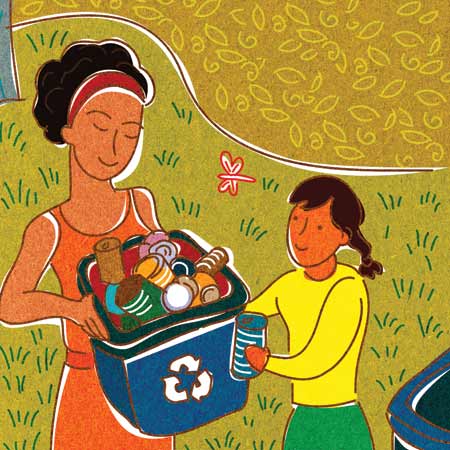
(Photo courtesy Shutterstock)
Cling … Clang … Clank. From inside my apartment, I winced at the noise my parents were making as they sorted bottles and cans out on the cramped balcony. With as much enthusiasm as I could muster, I called to my mother in Chinese, “How many do you have this time?”
“Eight hundred and six pieces, that’s $40.30!” she answered. “That makes it $309.55 in total — a decent month’s salary back home!”
I’d been living in my West Los Angeles apartment for a little over four years when my parents came for a six-month visit from the town in northeastern China where I grew up. Just a few weeks into their stay, my mother had appointed herself CFO of recycling. I’d casually mentioned that the plastic water bottle and aluminum can they’d noticed on the curb were worth 5 cents each. I had no idea that simple revelation would open such a can of worms —“golden” worms as far as my parents were concerned.
For the next several months, my building endured the clutter and clamor of my parents’ enthusiastic recycling. At dinnertime, Mom and Dad took turns recounting a list of perfectly usable things they had seen being thrown out that day. When their stay with us ended, I must confess that I felt free and relieved (and then guilty). I suspect my neighbors noticed their absence immediately. My balcony reverted to its role as a tiny garden.
Little did I know, though, that only a few months later I would be cluttering that balcony right up again and informing my parents that they had inspired me to start a recycling fundraiser at my daughter’s school. I named it the Green for Green program. To date it has brought in — bottle by bottle, can by can — more than $15,000.
When I was growing up in China, parental involvement at school was limited to attending parent-teacher conferences to discuss academic issues. Schools were free but with very limited resources (no library, gym, or science labs) and huge class sizes: up to 60 students. Students helped clean and make simple repairs. Schools operated within their means, and fundraising didn’t exist.
By the time I had a daughter of my own and she began school, I had lived in America for six years and become an American citizen. Although I considered myself pretty well assimilated, I was confused and skeptical when I first heard that I was expected to raise funds for the school. If American public schools are free, how come they keep asking for money? While fundraising for public school was a foreign concept to me, recycling was not. Wastefulness (langfei in Chinese) has been considered a vice since the earliest Chinese cultures. My parents, like most Chinese people of their generation, use everything to death, beyond the point of any possible salvage, and then they still save it just in case. Reduce, Reuse, and Recycle was a principle of survival. One of the first children’s rhymes I learned was, “Every grain of rice represents a drop of farmer’s sweat.”
During years of strict rationing in the 1970s, my mom even saved her shoelaces, unraveling them into yarn to knit mittens for me. Many of my clothes were altered hand-me-downs from my mom, aunts, and grandmother. Every scrap of cloth was used as a patch, a doll’s dress, or a rag. Dogs and cats ate people’s leftovers, and restaurants raised pigs in the backyard to feed on customers’ leftovers. When a junk collector came through the neighborhood with a wheelbarrow, chanting “Shou po lan!” (“Junk collection!”), my neighbors would chase him down with saved-up cardboard, paper, glass, metal — and sometimes even hair — to exchange for money. We went to the market with our own baskets and carried our grains and flour home in cloth bags made from used bedsheets.
When I first arrived in the U.S., I was amazed by garage sales and what they suggested: waves of new purchases rolling in, and waves of old purchases, now unwanted clutter, rolling out. Although many conscientious Americans make an effort to recycle at home, I have seen little public infrastructure set up here to make it as easy as consuming and wasting — not even, to my astonishment, in schools. We sometimes seem to be too wealthy for our own good.
But economic setbacks hit us too. During the recent economic recession, my daughter’s school, the Los Angeles Center for Enriched Studies (LACES), lost hundreds of thousands of dollars in state and federal support, including $300,000 in Title I funding (earmarked to help schools with a large percentage of students from low-income families).
I felt heavy pressure to help raise funds for my daughter’s school. At the same time, I have long felt strongly about environmental education. How could I get the whole community excited about “Reduce, Reuse, Recycle” during such a stressful and cash-strapped time? That’s when it hit me: how about uniting the two? LACES has more than 1,600 students, teachers, and staff. If my two elderly parents could raise $300 in six months from recycling, why couldn’t our school multiply that number by at least 800?
And so I approached the president of the LACES parent organization. She put me in touch with key adults: the principal, the plant manager, the school police officer, the student leadership teacher, and a few motivated parents. I found a recycling center a mile away from LACES, and its manager agreed to pick up our recyclables at our school. I ordered more recycle bins from the city, got free stickers and posters from calrecycle.ca.gov, and wrote a speech to motivate parents and teachers. The LACES principal, Harold Boger, authorized me to create and manage a Green Team page on the school’s website. I recruited volunteers at parent meetings and created an account at signupgenius.com to manage scheduling.
Next, I went to talk to the students. The leadership students at LACES are eloquent, confident, and academically successful. They have been hearing the “Reduce, Reuse, Recycle” slogan since they were in kindergarten, and they were eager to take responsibility and lead a change. However, they wanted to take charge of the outreach themselves. So we agreed the parent team would simply provide the materials and arrange to haul loads to the recycling center to redeem them.
After all that work, our first two trips to the recycling center yielded $114. I went back to the drawing board. My committee and I organized a day for students and parents to bring bottles and cans directly to school. We called it the Green for Green drive. The first one raised only $145. But I scheduled more drives. With each one, the numbers started to look better: $145 … $400 … $481. Now we were getting somewhere!
We kept improving the system. We put locks on the campus recycle bins and cut bottle-size holes on the top of each bin so students could drop bottles in and scavengers couldn’t take them out. I kept on campaigning, with heartfelt pleas, educational and funny YouTube video clips, and poems. We scheduled student assemblies. I got a parent to donate a large banner to hang in front of the school building. I went to neighborhood council meetings. The principal added a reminder about our Green for Green drives to his weekly, automated phone calls home. I made a math-themed slogan: 1,666 students x 12 bottles or cans x $.05 = $1,000.
The more success we had, the more people joined our team. Eventually, we began to save, crush, sort, and bag returnables like a well-oiled machine. Today, LACES teachers keep boxes in their classrooms for bottles and cans. Leadership students collect recyclables and store them in locked bins. Parents collect at their offices and sporting events. We’re working on getting donations from a local office building. On many occasions LACES parents have told me about their own cluttered balconies and garages and how they no longer see litter, they see money.
Getting parents together to share some dirty work at the school twice a month has also turned out to be a marvelous community-building exercise. A year ago, my daughter’s school friends told her they felt weird bringing their used containers to school. Now, I see them helping unload bags from their parents’ cars as they are dropped off at school. Hundreds of people — parents, students, and occasionally people from the neighborhood — bring bags of returnables with them from all over the city. Twenty parent volunteers sort and bag, chatting about the latest news at the school and meeting new friends. In an hour, a pile of plastic bottles, aluminum cans, and clear, green, and brown glass bottles are neatly sorted by material type and bagged for pickup.
Since the LACES Green for Green program started in Fall 2011, LACES students and parents have raised approximately $15,500 for the school and recycled about 75,000 pounds of waste. I know that $15,500 is a drop in a bucket, but for us it means 5 percent of the funding for over 20 programs, including our school choir, Math Mania, general scholarships, technology support, school buses, and nurse days. I take great satisfaction in knowing that this modest program motivates the community to extract money from waste and that everyone, no matter their financial means, can contribute.
Looking back, I see that although I spearheaded the charge, success requires community. I believe that most people want to contribute, but it’s a lot more motivating when you feel that you belong to something bigger, that your effort is matched by the others in the community, and that the result is multiplied. During the past two years, news of Green for Green’s success has spread to other school communities through word of mouth. I have received emails and phone calls from parents at other schools asking to share what wisdom I have gained. I’m proud to think that the LACES recycling effort may have snowballed.
I used to laugh at my parents’ frugality when I was young, having never experienced starvation or rationing like they did. I laughed again at their recycling project during their six-month visit here. Now I laugh at myself for having benefited from their wisdom. They may never have intended to influence anyone beyond their family, but their small effort has led to bigger change, one that inspires family, friends, children, co-workers, and even strangers.
Who knows what they’ll inspire on their next visit—a solution to L.A.’s water shortage?